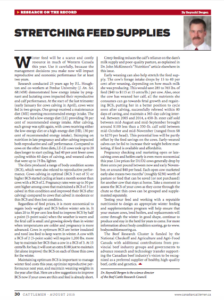Stretching Feed Supplies
This article written by Dr. Reynold Bergen, BCRC Science Director, originally appeared in the August 2015 issue of Canadian Cattlemen magazine and is reprinted on the BCRC Blog with permission of the publisher.
Remarque : cette page web n’est actuellement disponible qu’en anglais.
Winter feed will be a scarce and costly resource in much of Western Canada this year. Use it carefully, because the management decisions you make now will impact reproductive and economic performance for at least two years.
Research conducted 25 years ago by P.L. Houghton and co-workers at Perdue University (J. An. Sci. 68:1438) demonstrated how energy intake by pregnant and lactating cows impacted their reproductive and calf performance. At the start of the last trimester (early January for cows calving in April), cows were fed in two groups. One group received a maintenance diet (ME) meeting recommended energy intake. The other was fed a low energy diet (LE) providing 70% of recommended energy intake. After calving, each group was split again, with cows receiving either the low energy diet or a high energy diet (HE; 130% of recommended energy intake). Skimping on nutrition in late pregnancy and after calving impacted both reproductive and calf performance. Compared to cows on the other three diets, LE-LE cows took up to 20 days longer to start cycling, had 40% fewer cows cycling within 60 days of calving, and weaned calves that were up to 73 lbs lighter.
The diets produced a range of body condition scores (BCS), which were also related to reproductive performance. Cows calving in optimal (BCS 3 out of 5) or higher BCS started cycling at least a month sooner than cows with a BCS of 2. Pregnancy rates were up to 30% higher among cows that maintained a BCS of 3 (or calved in thin condition and improved their BCS after calving) compared to cows that calved in moderate or thin BCS and then lost condition.
Regardless of feed prices, it is more economical to regain body weight and BCS before winter sets in. It takes 20 to 30% less feed to improve BCS by half a point (5 point scale) when the weather is warm and the fetal calf is small and growing slowly than in winter when temperatures are colder and pregnancy is more advanced. Cows in optimum BCS are better insulated and need less feed to keep warm in winter. A cow with a BCS of 2 (5 point scale) will require 1200 lbs more hay to maintain her BCS than a cow in a BCS of 3. At 15₵/lb for hay, it will cost an extra $180 just to maintain (let alone improve) the BCS on each of those thin cows for the winter.
Maintaining optimum BCS is important to manage winter feed costs this year, optimize reproductive performance next year, and maintain weaning weights in the year after that. Here are a few suggestions to improve BCS now if your cows are thin and feed is already short.
Creep feeding reduces the calf’s reliance on the dam’s milk supply and poor quality pasture, as explained in Dr. John McKinnon’s “Nutrition” article elsewhere in this issue.
Early weaning can also help stretch the feed supply. The cow’s forage intake drops by 15 to 40% after weaning, depending on how much milk she was producing. This would save 285 to 765 lbs of feed (t 15₵/lb) per cow. Also, once the cow has weaned her calf, all the nutrients she consumes can go towards fetal growth and regaining BCS, putting her in a better position to cycle soon after calving, successfully rebreed within 80 days of caving, and maintain a 365 day calving interval. Between 2005 and 2014, a 450 lb steer calf sold between mid- August and mid-September brought around $100 less than a 550 lb calf sold between mid-October and mid-November (ranged from $8 to $270 per head). This potential loss will be partly offset by the feed savings on the cows. Early-weaned calves can be fed to increase their weight before marketing, if feed is available and affordable.
Pregnancy checking and marketing open or late-calving cows and heifers early is even more economical this year. Live prices for D1/D2 cows generally drop by 3 cents per pound between now and early November, or around $40 per head. Each open cow marketed early also means two months’ (roughly $230) worth of pasture or feed that can be saved (or not purchased) for another cow that stays at home. Take a moment to assess the BCS of your cows as they come through the chute so that thin cows can be grouped and supplemented separately.
Testing your feed and working with a reputable nutritionist to design an appropriate winter feeding and supplementation program will help ensure that your mature cows, bred heifers, and replacements will come through the winter in good shape, continue to produce and stay in the herd for years to come. For more information about body condition scoring.
Click here to subscribe to the BCRC Blog and receive email notifications when new content is posted.
The sharing or reprinting of BCRC Blog articles is typically welcome and encouraged, however this article requires permission of the original publisher.
We welcome your questions, comments and suggestions. Contact us directly or generate public discussion by posting your thoughts below.
